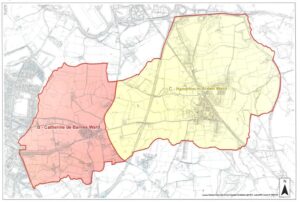The Parish incorporates two Wards, based on the historic settlements of Hampton-in-Arden and Catherine-de-Barnes.
Hampton-in-Arden and Catherine-de-Barnes.
Hampton-in-Arden has been a settlement since Saxon time and is recorded as Hamtone in the Domesday Book of 1086. As well as being an important settlement in the original Forest of Arden, Hampton was on the salt route from Droitwich to Coventry and beyond and the medieval Packhorse Bridge (an Ancient Monument) still stands as a reminder of the important river crossing. The George Fentham Trust has had a major impact upon the village. The charitable trust has resulted in the construction of a number of buildings of importance. A further influence was Sir Frederick Peel, son of Sir Robert Peel, who inherited the Hampton Manor Estate on the death of his father in 1850. He built the present Manor House in 1855 (a Grade II listed building) and employed a well known architect W. Eden Nesfield, to design the Manor Clock Tower (a Grade II* listed building) and a number of village houses (including a number of cottages in the High Street).
Since 1968 the central part of Hampton-in-Arden has been designated a Conservation Area. The Conservation Area Appraisal, produced by Solihull MBC, identifies key positive characteristics of the village and makes a number of recommendations to further protect its character. A number of buildings within the village are listed and many are important historically and architecturally. These include the Church, Hampton Manor, Beech House, Moat House, Fentham Hall, the White Lion Inn public house, the war memorial, the telephone kiosk, the library, the old railway station, and several of the properties along the High Street. Surrounding the village are a number of other Listed Buildings, including Diddington Hall (a Grade II* listed building, built around 1580), Mouldings Green Farmhouse (built around 1600) and Meriden Mill Farmhouse (17th century).
There is no ‘Catherine’ after whom Catherine de Barnes is named. Its name originates from Ketelberne, the family who owned it after the Norman Conquest in 1066. At the time of the Domesday record the settlement formed part of the Manor of ‘Langedon’. However, the village we know today is mainly a later settlement, mostly dating from the building of the Grand Union Canal; St Catherine’s School and Chapel, now a village hall, was built by Joseph Gillott in 1879.
In 1907, a ‘fever hospital’ was built in the village as a joint operation of the Solihull and Meriden Councils for isolating patients with infectious diseases such as diphtheria, typhoid fever and smallpox. In 1978, Janet Parker, the last known victim of smallpox in the world, died here. The hospital closed in the mid-1980s and in 1987 was converted to residential use.
There are a number of listed farmhouses in Catherine de Barnes, including Bogay Hall and Old Berry Hall, both dating from around 1500.
There are three Scheduled Ancient Monuments present within the Parish:
- the Packhorse Bridge;
- the moated site at Moat House in Hampton in Arden; and,
- the Churchyard cross in St Mary and St Bartholomew’s churchyard
